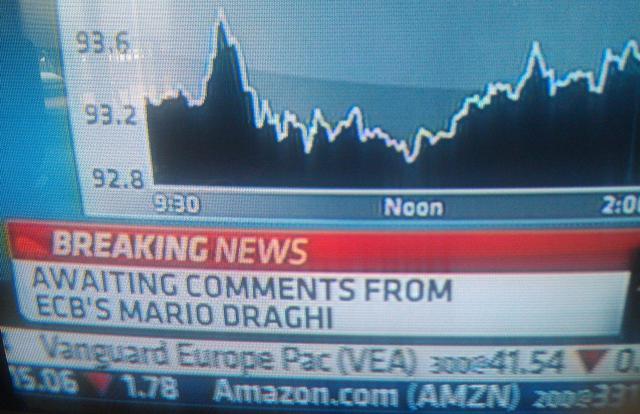 About 2 years after he began trying to convince the world that he was the biggest and baddest central banker around, unafraid to whip out any part of his arsenal to fight a slumping European economy, Mario Draghi finally has decided to let actions speak for themselves.
About 2 years after he began trying to convince the world that he was the biggest and baddest central banker around, unafraid to whip out any part of his arsenal to fight a slumping European economy, Mario Draghi finally has decided to let actions speak for themselves.
With only a single mandate as a master, although hampered by many national masters in the European Union, a European version of Quantitative Easing will be introduced a mere 5 years after it was begun in the United States.
While in the past the bravado of Draghi’s words have spurred our markets higher and the lack of action have led to disappointment, this week’s details of the planned intervention were more than the previous day’s rumor had suggested and after a very short period of second guessing the good news delivered, the market decided that the ECB move would be very positive for stocks and had another one of those strong moves higher that you tend to see during bear markets.
We’ve had a lot of those, lately.
Whether an ECB quantitative easing will be good for US stock markets in the longer term may be questionable, much like the FOMC’s period of QE did little to promote European equity markets, but almost certainly gave home markets an advantage.

While US markets greatly out-performed their European counter-parts from the time QE was initially announced, they were virtually identical in performance for the preceding 10 year period.
If you are among those who believe that the great returns seen by the US markets since 2009 were the result of FOMC actions, then you probably should believe that European markets may now be relatively more attractive for investors. Besides, add the current strength of the US dollar into the mix and the thoughts of bringing money back to European shores and putting it to work in local markets may be very enticing if that puts you on the right side of currency headwinds.
The only real argument against that logic is that the FOMC’s actions helped to drive interest rates lower, making equities more appealing, by contrast. However, how much lower can European rates go at this point?
Meanwhile, although there is now a tangible commitment and the initial market action was to embrace the plan with open arms and emptied wallets in a knee jerk buying spree, there’s not too much reason to believe that it will offer anything tangible for markets immediately, or at all.
In the US experience we have seen that the need for and size of the intervention and the need for its continuation or taper begins the process of wondering whether bad news is good or good news is bad and introduces more paradoxical kinds of reactions to events, as professional traders become amateur reverse psychologists.

As markets may now take some time to digest the implications of an ECB intervention for at least the next 18 months, the question at hand is what will propel US markets forward?
Thus far, expectations that the benefit of lower energy prices will be that catalysts hasn’t been validated by earnings or forward guidance, although key reports, especially in the consumer sector are still to come. One one expect that the significant upward revisions of GDP would eventually make their way into at least the top line of earnings reports by the next quarter and might find their way into guidance during this quarter’s releases.
In addition to guidance from the consumer sector, earnings news and guidance from the energy sector, if pointing to bottom lines that aren’t as bad as the stock sell-offs would have indicated, could go a long way toward pushing the broader market higher. Some early results from Schlumberger (NYSE:SLB) and Halliburton (NYSE:HAL) are encouraging, however, the coming two weeks may supply much more information as a number of major oil companies report earnings.
Of course, next week we could also return to an entirely US-centric news cycle and completely forget about European solutions to European woes. First comes an FOMC Statement release on Wednesday and then GDP statistics on Friday, either of which could cast some doubt on last week’s Retail Sales statistics that took many by surprise by not reflecting the increased consumer spending most believed would be inevitable.
The real test may be whether earnings can continue to meet our expectations as buybacks that had been inflating EPS data may be slowing.
Still, focusing on earnings is so much better than having to think about fiscal cliffs and sequestration.
As usual, the week’s potential stock selections are classified as being in Traditional, Double Dip Dividend, Momentum or “PEE” categories. Additional earnings related trades may be seen in an accompanying article.
Dow Chemical (NYSE:DOW) reports earnings this week, but I’m not looking at it as an earnings related trade in the manner that I typically do, through the sale of out of the money puts.
In this case, I’m interested in adding shares to my existing holdings in the belief that Dow Chemical shares have been unduly punished as energy prices have plunged. While it does have some oil producing partnerships with Kuwait, as its CEO Andrew Liveris recently pointed out during the quiet period before upcoming earnings, Dow Chemical is a much larger user of oil and energy than it is a producer and it is benefiting greatly from reduced energy costs.
The market, however, hasn’t been seeing it the same way that Liveris does, so there may be some positive surprises coming this week, either for investors or for Liveris, who is already doing battle with activist investors.
While I generally like to sell near the money options on new positions, in this case I’m more interested in the potential of securing some capital gains on shares and would take advantage of the earnings related enhanced option premiums by selling out of the money calls and putting some faith in Liveris’ contention.
I can’t begin to understand the management genius of Richard Kinder and his various strategic initiatives over the years, nor could I keep track of his various companies. News of his decision to step down as CEO of Kinder Morgan (NYSE:KMI) seems well timed, considering the successful consolidation of the various companies bearing his name. In what may be the last such transaction under his leadership, a very non-distressed Kinder Morgan made an acquisition of a likely more distressed privately held Harold Hamm company with interests in the Bakken Formation.
What I do understand, though, is that shares of Kinder Morgan are ex-dividend this week and despite it being in that portion of the energy sector that has been largely shielded from the price pressures seen in the sector, it is still benefiting from option premiums that reflect risk and uncertainty. Getting more reward than you deserve seems like a good alternative to the more frequently occurring situation.
In a world where “old tech” has regained respect, not many are older than Texas Instruments (NASDAQ:TXN). It, too, goes ex-dividend this week, but does so two days after its earnings are released.
With shares less than 2% below its 52 week high, I’m reluctant to buy shares when the market itself has been so tentative and prone to large and sometimes unforeseen moves in either direction. However, in the event of a sizable decline after Texas Instruments reports earnings I may be interested in purchasing shares prior to the ex-dividend date.
Fastenal (NASDAQ:FAST) is also ex-dividend this week. While I generally don’t like to add shares at a higher price, having just bought Fastenal immediately before earnings and in replacement of shares assigned the previous month at a higher price, that upcoming dividend makes it hard to resist.
Fastenal, despite everything that may be going on in the world, is very much protected from the issues of the day. Low oil prices and a strong dollar mean little to its business, although low interest rates do have meaning, insofar as they’re conducive to commercial and personal construction projects. As long as those rates remain low, I would expect those Fastenal parking lots to be busy.
While there’s nothing terribly exciting about this company it has become one of my favorite stocks, while trading in a fairly narrow range. Although priced higher than my current lot of shares, it’s priced at the average entry point of my previous 10 positions over the past 18 months
The option market is implying a 6.2% price move, which is low compared to recent quarters, however, that is a theme for this week for a number of other companies reporting earnings this week.
Additionally, the cushion between the lower range strike price determined by the option market and the strike level that would return my desired 1% ROI isn’t as wide as it has been in the past for Facebook. That strike is 6.8% below Friday’s closing price.
For that reason, while I’ve liked Facebook in the past as an earnings related trade and still do, the likelihood is that if executing this trade I would only do so if shares show some weakness in advance of earnings or if they do so after earnings. In those instances I’d consider the sale of out of the money put contracts. Due to the high volume of trading in Facebook options it is a relatively easy position to rollover if necessary due to a larger than expected move lower, although I wouldn’t be adverse to taking possession of shares and then managing the position with the sale of calls.
American Express (NYSE:AXP) was another casualty within the financial services sector following its earnings report this past week, missing on both analyst’s estimates and its own projections for revenue growth. That disappointment added to the decline its shares had started at the end of 2014.
Since that time, while the S&P 500 has fallen 1.5%, American Express shares had dropped nearly 11%, exacerbated by disappointing earnings, with analysts concerned about future costs, despite plans to cut 4000 employees.
The good news is that American Express has recovered from these kind of earnings drops in he past year as they’ve presented buying opportunities. Along with the price drops comes an increase in option premiums as a little bit more uncertainty about share value is introduced. That uncertainty, together with its resiliency in the face of earnings challenges may make this a good time to consider a new position.
Finally, I wasn’t expecting to be holding any shares of MetLife (NYSE:MET) as Friday’s trading came to its close, having purchased shares last week and expecting them to be assigned on Friday, until shares followed the steep decline in interest rates to require that their option contracts be rolled over.
What I did expect, seeing the price head toward $49 in the final hour of trading was to be prepared to buy shares again this week and that expectation hasn’t changed.
What is making MetLife a little more intriguing, in addition to many others in the financial sector, is the wild ride that interest rates have been on over the past 2 weeks, taking MetLife and others along. With those rides comes enhanced option premiums as the near term holds uncertainty with the direction of rates, although in the longer term it seems hard to believe that they will stay so low as more signs of the economy heating up may be revealed this week.
With shares going ex-dividend on February 4, 2015 and earnings the following week, I may consider a longer term option contract to attempt to capture the dividend, some enhanced premiums, while offering some protection from earnings
surprises through the luxury of additional time for shares to recover, if necessary.
Somewhere along the line a decision will be made regarding the designation of MetLife as a “systemically important” financial institution that is “too big to fail.” While re-affirming that designation, despite MetLife’s protests that has negative consequences, I think that has already been factored into its share price, although it may result in some more dour guidance at some point that will still come as a surprise to some.
Traditional Stocks: American Express, Dow Chemical, MetLife
Momentum Stocks: none
Double Dip Dividend: Fastenal (1/28), Kinder Morgan (1/29), Texas Instruments (1/28)
Premiums Enhanced by Earnings: Facebook (1/28 PM)
Remember, these are just guidelines for the coming week. The above selections may become actionable, most often coupling a share purchase with call option sales or the sale of covered put contracts, in adjustment to and consideration of market movements. The overriding objective is to create a healthy income stream for the week with reduction of trading risk.

 What a week.
What a week. The problem is that it can be a precarious balance for the Russian President between the need to support his ego and the need to avoid cutting off one’s own nose while spiting an adversary.
The problem is that it can be a precarious balance for the Russian President between the need to support his ego and the need to avoid cutting off one’s own nose while spiting an adversary. It’s too bad that life doesn’t come with highly specific indicators that give us direction or at least warn us when our path isn’t the best available.
It’s too bad that life doesn’t come with highly specific indicators that give us direction or at least warn us when our path isn’t the best available.

 This past week was one when neither decisions nor inputs were really required from investors as the market had its best week in about four months. With the exception of a totally inconsequential FOMC statement release, there was absolutely no economic news, or really no news of any kind at all. In fact, awaiting the scheduled remarks from Mario Draghi was elevated to the status of “breaking news” as most people were tiring of seeing celebrities getting doused with a bucket of ice, under the guise of being news.
This past week was one when neither decisions nor inputs were really required from investors as the market had its best week in about four months. With the exception of a totally inconsequential FOMC statement release, there was absolutely no economic news, or really no news of any kind at all. In fact, awaiting the scheduled remarks from Mario Draghi was elevated to the status of “breaking news” as most people were tiring of seeing celebrities getting doused with a bucket of ice, under the guise of being news.

 People tend to have very strong feelings about entitlements.
People tend to have very strong feelings about entitlements. 

 It only seems fitting that one of the final big stories of the week that saw the Dow Jones eclipse its nearly 6 year old record high would be the latest reports of how individual banks performed on the
It only seems fitting that one of the final big stories of the week that saw the Dow Jones eclipse its nearly 6 year old record high would be the latest reports of how individual banks performed on the